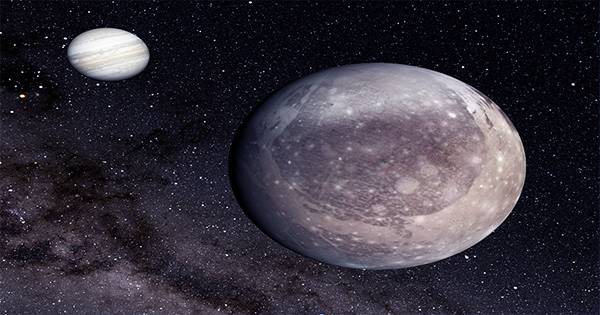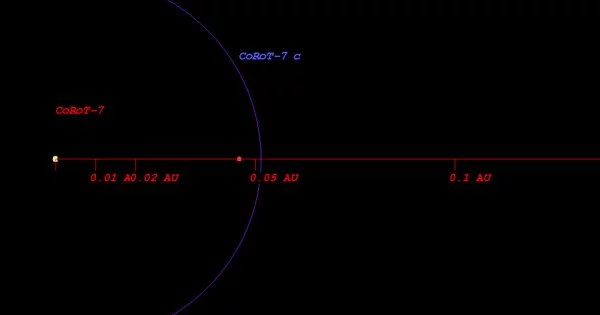It’s not often that a fresh impact crater on the Moon appears out of nowhere, but that’ll happen on March 4 when a derelict SpaceX Falcon 9 rocket collides with it. Naas’s Deep Space Climate Observatory (DSCOVR) probe was launched into a position 1.5 million kilometers from Earth, facing the Sun, by the rocket in 2015. However, the rocket’s spent upper stage was unable to escape into an independent orbit around the Sun, and it was abandoned without the ability to guide back into the Earth’s atmosphere. That would be standard procedure, allowing stages to burn up on re-entry, lowering the amount of harmful debris in near-Earth space.
The derelict upper stage, which is 14 meters long and weighs roughly four tons, has been in a broad orbit above the Earth since February 2015. Because it was impacted by lunar and solar gravity as well as the Earth’s, its precise movements were difficult to predict. However, we now know that it will strike the Moon on March 4 at a speed of 2.6 kilometers per second. This will create a crater with a diameter of around 19 meters, which has sparked indignation on social media from individuals who are outraged that human negligence will deface the Moon in this way.
A dead rocket landing on the Moon, on the other hand, is unquestionably more environmentally benign than being spread through Earth’s upper atmosphere as metal oxide particles during a re-entry burn up. Because the Moon lacks an atmosphere to protect it from space debris, it is constantly acquiring naturally occurring impact craters. On March 17, 2013, a natural impact created a 19-meter lunar crater. Arizona State University/NASA/Goddard Space Flight Center
The Lunar Reconnaissance Orbiter has already captured images of a 19-meter crater created in March 2013 when a half-tonne chunk of asteroid rock traveling ten times faster than the Falcon 9 collided with the surface. Nasa’s lunar impact monitoring project has detected hundreds of smaller impacts involving bits of rock weighing as little as half a kilogram over the last decade.
We won’t be able to view the upcoming collision because it will occur on the far side of the moon. After then, spacecraft circling the Moon will be able to photograph the impact crater. Will we be able to learn something new? We’ve seen numerous deliberate impacts on the Moon before, so we know what to expect. The much larger upper stages of the rockets used in the Apollo landing missions, for example, were crashed so that vibrations measured by seismometers on the surface could be utilized to probe the lunar interior.
The seismometers on the Apollo spacecraft were shut off a long time ago, and it’s unclear whether the seismometer aboard China’s Chang’e 4 far side lunar lander will produce any valuable data this time. In 2009, Naas’s LCROSS mission sent a projectile into a permanently shadowed polar crater, creating a smaller crater on its icy bottom and ejecting a plume that included the hoped-for water vapour.
So I’m not worried by yet another crater on the Moon. It already has about a half-billion craters with a diameter of ten meters or more. What we should be concerned about is contaminating the Moon with living bacteria or compounds that might be misconstrued for proof of previous life on the Moon in the future. The majority of countries have agreed to planetary protection guidelines, which aim to reduce the possibility of biological contamination from Earth to another body (and also from another body back to Earth). The protocols are in place for ethical and scientific reasons.
The ethical issue is that introducing organisms from Earth that might flourish on another body would jeopardize any ecosystem that may exist there. The scientific argument is that we want to study and understand the natural conditions on each other’s bodies, thus we shouldn’t risk contaminating or damaging them. In 2019, the privately sponsored Israeli lunar lander Beresheet crashed on the Moon, bringing DNA samples and hundreds of tardigrades. This was the most recent infringement of the COSPAR rules. These are half-millimetre-long organisms that can endure, but not actively function in, space vacuum.
These, as well as the bacteria that dwelt in their intestines, are now strewn about the crash site at Beresheet. Most of these will most likely not wind up in a niche with enough water to revive and become active, but that is not a chance we should take. The DSCOVR Falcon 9 wasn’t sterile when it launched, but it didn’t have any biological payload either. It’s already been seven years in space, so the chance of biocontamination is nil – but the more we send to the Moon, the more cautious we must be, and the more difficult it will be to enforce any standards.
















